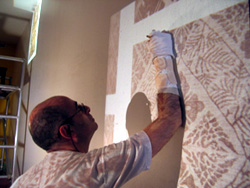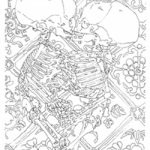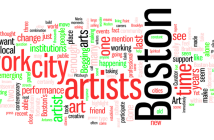I watched The Matrix: Reloaded for the first time a few days after seeing Maurizio Cannavacciuolo’s “TV Dinner” installation at the Isabella Stewart Gardner Museum, and well, I confess that the Matrix actually aided my contextualization Cannavacciuolo’s work. It also helped that I watched the film on my Floridian uncle’s gigantic television upon which a life size monkey comprised of wood and leather stands in an aggressive pose next to two wooden nutcrackers and a diminutive wooden Santa; all the while a Jack Russell Terrier stared at me and I mused about it jumping into lemonade pitcher. The Matrix: Reloaded does its best to include the philosophy which its narrative purports to base itself on, with Baudrillard’s “Simulacra and Simulation” making a guest appearance as well as Cornel West himself playing the role of a councilor of Zion with the ostentatious line “Comprehension is not requisite for cooperation.”
In a short interview, included in the exhibition pamphlet for “TV Dinner,” Cannavacciuolo was asked “Why TV Dinner?” He replied, “Because the TV dinner in front of a TV set can fill your stomach and your brain without leaving anything good in either case.” I must confess that I have little knowledge of TV dinners (growing up, my parents taught my siblings and I to look upon such ready-made meals with disdain) but the one time in my life that I ate one was while watching the original “King Kong,” (1933) and I was left with the childhood trauma of the sight of a giant gorilla machine-gunned to death atop a sky-scraper and the taste of charred brownie (this was before my family purchased a microwave). But the significance of the TV dinner to Cannavacciuolo is not so much the meal itself, but the act of eating said meal while watching television.
Television is a scattered mish-mash of texts and symbols and in many ways the closest manifestation of the Baudrillardian Simulacrum. “TV Dinner” is doubtlessly a metaphor for mass media even if not Baudrillard’s theory. It is a veritable Super Bowl half-time show: its deluge of images caters to all of us, but the images, as symbols and texts, blend together to efface their meaning and to create new ones. Where The Matrix attempts a self-aware dialogue on pop-philosophy and the Simulacrum, Cannavacciuolo actually participates in it and goes so far as to place you in a “virtual” simulacrum.
Several walls in bold primary colors confront you as you walk into the space, but to the right and left are typical gallery-white walls covered in faint pencil drawings. The drawings, resembling a wall-sized paint by number graphic, are so slight that the gallery’s lighting actually bleaches them out where it directly strikes the wall in relation to where you stand. It is impossible to step back and take in the entire work; you must focus closely on a one-foot square area in order to see anything intelligible.
The museum encourages you to “look beyond the bold primary wall colors and allow your eye to adjust to the rooms lighting, [so]a delicate web of images [can]slowly come into focus.” Cannavacciuolo indeed designed the installation to force the viewer to “look beyond.” The primary colors distract you from the drawings whose subtlety in execution already necessitates your concentration. The individual images themselves fade into one another with a visual logic that indeed brings to mind the ordering of television commercials. Our brains must work harder in order to distinguish meanings in a simulacrum just as we need to work to distinguish individual images in the work. In fact, the visual subjects of the work may undermine the Gardner’s methodology as a collector: When taken in as a whole, it is a heap of detritus, and Cannavacciuolo uses images of the Gardner’s collection among many from pop culture (as well as some from his own work, perhaps to lend some self-awareness to this apparent misdeed) to channel a representation of simulacra. The individual images that make up the piece can be striking, as well as the juxtapositions created by them. Cannavacciuolo surrounds a young girl with images of hand guns and images of homoeroticism arise here and there (a popular theme in his work), but in the context of the piece they lose their meaning, just as Cornel West does in The Matrix and Nelly’s scantly clad and suggestively writhing dancers in the Super Bowl half-time show receive no attention, yet Janet Jackson’s supposedly accidental breast baring rewrites the censor’s policy.
- At detail of TV Dinner
- Cannavacciuolo working on his installation at the Gardner.
Links:
Read an interview with the artist
"T.V. Dinner: Maurizio Cannavacciuolo" is on view through August 15 at the Isabella Stewart Gardner Museum.
All images are courtesy of the artist and the Gardner Museum
Christian Holland is a regular contributor to Big, Red & Shiny.
The writer would like to thank Lazaro Montano, an assistant of Cannavacciuolo’s for the work’s installation, for his generous contributions of insight on Cannavacciuolo.





